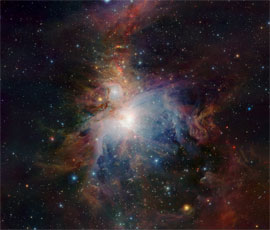Orion in a new light
The hidden secrets of the Orion Nebula are revealed in a dramatic image taken by the new VISTA telescope.

Designed and built by a team of scientists led by Queen Mary, University of London, the survey telescope’s huge field of view can show the full splendour of the whole nebula.
VISTA’s infrared vision also allows it to peer deeply into dusty regions that are normally hidden, and expose the curious behaviour of the very active young stars buried there.
Professor Jim Emerson, leader of the VISTA consortium from Queen Mary's Astronomy Unit said: "When I started in infrared astronomy we had to collect data with 1 pixel cameras. The UK expertise that designed and built VISTA now enables us to acquire images like this with 100s of millions of pixels. It's amazing how much this will push forward the frontiers of our knowledge of star formation."
The Orion Nebula is a vast stellar nursery lying about 1350 light-years (about a million billion kilometers) from Earth. Although the nebula is spectacular when seen through an ordinary telescope, what can be seen using visible light is only a small part of a cloud of gas in which stars are forming.
Most of the action is deeply embedded in dust clouds and to see what is really happening astronomers need to use telescopes with detectors sensitive to the longer wavelength radiation that can penetrate the dust. VISTA has looked at the Orion Nebula using light wavelengths about twice as long as can be detected by the human eye.
VISTA - the Visible and Infrared Survey Telescope for Astronomy - is the latest addition to the European Southern Observatory (ESO)’s Paranal Observatory and it supported by the Science and Technology Facilities Council (STFC) in the UK. It is the largest survey telescope in the world and is dedicated to mapping the sky at infrared wavelengths. The large (4.1-metre) mirror, wide field of view and very sensitive detectors make VISTA a unique instrument.

Orion Nebula > Click for bigger
Credit: ESO/J. Emerson/VISTA. Acknowledgment: Cambridge Astronomical Survey Unit
This dramatic new image of the Orion Nebula illustrates VISTA’s remarkable powers. At the very heart of this picture lie the four bright stars forming the Trapezium, a group of very hot young stars pumping out fierce ultraviolet radiation that is clearing the surrounding region and making the gas glow. However, VISTA also reveals many other young stars in this central region that cannot be seen in visible light.
Looking to the region above the centre of the picture, curious red features appear that are completely invisible except using the VISTA telescope. Many of these are very young stars that are still growing and are seen through the dusty clouds from which they form. These strange features are of great interest to astronomers studying the birth and youth of stars.
"On the one hand the panoramic infrared overview given by VISTA's wide field of view shows the relationships between the young stars and the gas and dust they were born from. On the other hand, VISTA's exquisite detail and sensitivity allows us to find even very faint young stars" said Professor Emerson.
Related items
For media information, contact: